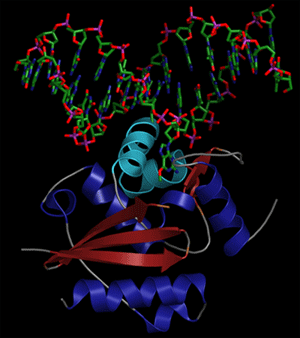
Numerous cellular and environmental agents constantly assault DNA in cells, causing a variety of types of DNA damage. Fortunately, an army of proteins stands ready to defend the cell's genetic blueprint by repairing this damage. The protein O6-alkylguanine-DNA alkyltransferase (AGT) is one soldier in this army, and serves to repair alkylation damage to guanine bases in the genome. Alkylated guanines incorrectly pair with thymine (rather than cytosine) during DNA replication, causing mutations. AGT prevents such mutations by transferring the alkyl group from alkylated guanines to a cysteine sidechain in its active site, in a non-enzymatic or 'suicide' reaction.
There can be benefits to DNA alkylation, though. Some of the oldest and most successful strategies for cancer chemotherapy involve using DNA alkylating agents to kill cells. Cancerous cells, because of their proliferating nature, are frequently more sensitive to these agents than normal cells. However, cancer cells can also hijack the protective function of AGT, and tumors that acquire resistance to alkylation chemotherapies frequently display elevated levels of AGT. Therefore, inhibitors of AGT given along with alkylating agents would help overcome tumor resistance to these therapies. One AGT inhibitor is currently in Phase II clinical trials, but suffers from poor solubility and only moderate affinity to AGT. We therefore initiated structural studies of AGT to provide a platform for design of improved inhibitors and to elucidate the protein's underlying biological mechanisms.
Crystals of a pre-transfer substrate complex were grown by mutating the active site cysteine to serine, thereby inactivating the protein, and incubating it with O6-methylguanine-containing DNA. To catch product complexes of AGT bound DNA, active AGT was allowed to react with DNA containing N1,O6-ethanoxanthine, a modified DNA base that mimics the natural substrate of AGT, but permanently crosslinks the protein to the DNA. These analogs were designed and synthesized by our collaborators Neil Clarke and David Noll at Johns Hopkins University. Crystals of AGT-DNA complexes were typically characterized by a high solvent content and low resolution of diffraction, necessitating synchrotron radiation, and all data collection experiments were performed at SSRL.
The most surprising feature of the complexes is the way in which AGT binds DNA. AGT contains a structural motif called the helix-turn-helix (HTH) that is well established to bind DNA in a particular manner. Previous structural studies of the HTH have been primarily limited to transcription factors, which bind specific DNA sequences within the genome to regulate gene expression. These studies have universally shown that the HTH motif binds the major groove of DNA, which is perhaps not surprising because the sequence information encoded in DNA bases is most easily read through hydrogen bond patterns in the major groove (not all the information is accessible through the minor groove). Our studies show that AGT uses the HTH motif in an unprecedented fashion, binding the minor groove of DNA. In retrospect, this architecture is advantageous to the DNA repair function of AGT. Unlike transcription factors, DNA repair systems must bind DNA independent of the bases sequence in order to effect repair throughout the genome. Minor groove binding therefore seems advantageous in helping AGT to avoid any sequence dependence. We therefore predict that other HTH-containing proteins that bind DNA sequence independently will use this novel architecture. Likely suspects include proteins involved in chromosome structure, DNA repair and recombination, most notably the breast cancer associated protein BRCA2, RecQ helicases and linker histones.
Our structures also reveal how AGT accesses DNA bases and binds damaged guanines in its active site. A conserved tyrosine sidechain forces rotation of phosphates in the DNA duplex and phosphate rotation appears coupled to rotation of bases from the DNA base stack. An arginine from the HTH motif then replaces the extrahelical nucleotide. Hydrogen bonds in the active site, primarily from mainchain atoms, bind the extrahelical nucleotide and provide some selectivity for guanine over other DNA bases.
Before AGT can repair damaged guanine bases, it has to find them. Locating a few damaged bases within the context of genomic DNA (~108 bases) seems an immensely difficult problem. As part of our long-standing collaboration with the laboratory of Tony Pegg at the Pennsylvania State University School of Medicine, we have also reported biochemical studies addressing how AGT searches for DNA damage. These experiments suggest that rather than acting independently, multiple molecules of AGT act cooperatively to search DNA faster in a particular direction (3' to 5'), which might help explain the surprising efficiency of AGT. This mechanism seems particularly advantageous when coupled to the unidirectional motion of replication or transcription machinery, where it could repair damaged bases before they result in mutation.
D. S. Daniels, T. T. Woo, K. X. Luu, D. M. Noll, N. D. Clarke, A. E. Pegg and J. A. Tainer, "DNA Binding and Nucleotide Flipping by the Human DNA Repair Protein AGT", Nat. Struct. Biol. 11, 714 (2004)




